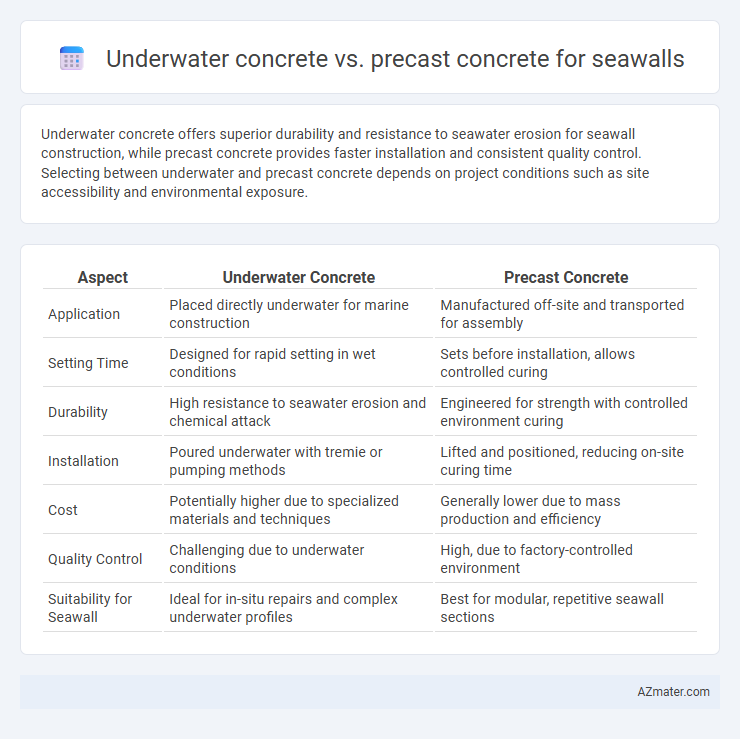Underwater concrete offers superior durability and resistance to seawater erosion for seawall construction, while precast concrete provides faster installation and consistent quality control. Selecting between underwater and precast concrete depends on project conditions such as site accessibility and environmental exposure.
Table of Comparison
| Aspect | Underwater Concrete | Precast Concrete |
|---|---|---|
| Application | Placed directly underwater for marine construction | Manufactured off-site and transported for assembly |
| Setting Time | Designed for rapid setting in wet conditions | Sets before installation, allows controlled curing |
| Durability | High resistance to seawater erosion and chemical attack | Engineered for strength with controlled environment curing |
| Installation | Poured underwater with tremie or pumping methods | Lifted and positioned, reducing on-site curing time |
| Cost | Potentially higher due to specialized materials and techniques | Generally lower due to mass production and efficiency |
| Quality Control | Challenging due to underwater conditions | High, due to factory-controlled environment |
| Suitability for Seawall | Ideal for in-situ repairs and complex underwater profiles | Best for modular, repetitive seawall sections |
Introduction to Seawall Construction Methods
Underwater concrete is specifically designed for placement in submerged conditions, allowing seamless integration into seawall foundations where water intrusion is inevitable, ensuring durability and structural integrity. Precast concrete units, fabricated in controlled environments, offer precision, rapid assembly, and reduced site labor, making them popular for seawall construction in tidal zones with varying water levels. Both methods address marine challenges differently, with underwater concrete emphasizing in-situ strength and adaptability, while precast concrete prioritizes uniform quality and faster installation times.
Overview of Underwater Concrete
Underwater concrete is specially formulated to resist washout and maintain its integrity when placed directly in marine environments, making it ideal for constructing seawalls. This concrete type typically incorporates anti-washout admixtures and has a higher slump to reduce segregation during underwater placement. Compared to precast concrete, underwater concrete allows for in-situ casting, providing better adaptation to irregular seabed conditions and enhanced bonding with surrounding materials.
Key Features of Precast Concrete
Precast concrete for seawalls offers high durability and consistent quality due to controlled factory conditions, ensuring resistance to saltwater corrosion and harsh marine environments. Its rapid installation minimizes construction time and environmental disruption compared to underwater concrete poured on-site. Enhanced structural integrity and customizable shapes make precast concrete ideal for seawalls requiring precise dimensions and robust performance against wave impact.
Installation Process Comparison
Underwater concrete installation for seawalls involves direct placement through tremie pipes to ensure proper setting and reduce segregation in submerged conditions, requiring specialized equipment and skilled labor. Precast concrete seawall segments are manufactured offsite with controlled quality and then transported and installed using cranes, offering faster assembly and reduced underwater work. The underwater concrete method demands more time for curing in situ, while precast concrete allows immediate structural integrity upon installation, optimizing construction timelines and minimizing environmental disturbance.
Durability and Longevity
Underwater concrete exhibits superior durability in seawall applications due to its enhanced resistance to chloride ion penetration and sulfate attack, which are critical in marine environments. Precast concrete offers controlled manufacturing conditions that improve its density and uniformity, contributing to long-term strength and reduced permeability against seawater exposure. Combining underwater concrete's robust chemical resistance with precast concrete's quality control optimizes seawall longevity by minimizing degradation and structural failure.
Cost Efficiency Analysis
Underwater concrete for seawalls offers direct placement advantages in submerged conditions, reducing labor and formwork costs but requiring specialized admixtures that increase material expenses. Precast concrete seawalls benefit from controlled factory conditions, enhancing quality and accelerating installation, leading to labor savings and shorter project timelines. Cost efficiency depends on project scale and site conditions, with precast concrete typically favored for repetitive units and underwater concrete preferred for complex or irregular underwater foundations.
Maintenance and Repair Considerations
Underwater concrete offers superior durability and resistance to marine environments, minimizing maintenance needs for seawalls exposed to constant water pressure and saline conditions. Precast concrete seawalls allow for easier and faster repairs, as damaged sections can be replaced without extensive underwater work, reducing downtime and repair costs. However, underwater concrete is typically preferred for long-term performance due to its ability to form monolithic structures that better withstand erosion and chemical attack.
Environmental Impact Assessment
Underwater concrete minimizes disturbance to marine ecosystems during seawall construction by allowing placement without dewatering, reducing sediment displacement and turbidity. Precast concrete seawalls, produced off-site, limit in-water construction time and prevent direct contamination but involve higher carbon emissions from transportation and manufacturing processes. Environmental Impact Assessment reveals underwater concrete offers superior habitat preservation while precast concrete supports better waste management and quality control, requiring a trade-off based on site-specific ecological priorities.
Suitability for Various Marine Conditions
Underwater concrete demonstrates superior adaptability in diverse marine environments due to its ability to cure and gain strength underwater, making it ideal for seawalls exposed to fluctuating tides and submersion. Precast concrete offers controlled quality and rapid installation but may require specialized joint treatments to withstand aggressive saltwater and wave impact in harsher conditions. Selection between underwater and precast concrete depends on site-specific factors such as water depth, current velocity, and exposure to marine erosion forces.
Final Recommendations for Seawall Projects
Underwater concrete offers superior durability and effective placement in submerged conditions, making it ideal for complex seawall repairs requiring quick setting and resistance to sulfate attack. Precast concrete provides consistent quality and faster installation for standardized seawall sections, reducing downtime and labor costs in projects with accessible staging areas. Final recommendations favor underwater concrete for in-situ, irregular foundations, while precast concrete is optimal for large-scale, modular seawall segments with controlled fabrication environments.

Infographic: Underwater concrete vs Precast concrete for Seawall
 azmater.com
azmater.com